In-Depth
Windows IT's Marching Orders
Network upgrades, improving security, adding new servers, Office 365 migration and Windows PC refreshes are among your top priorities, according to our latest reader survey.
At the Major League Soccer (MLS) headquarters in New York, John Sullivan has a lot on his plate. Sullivan, MLS vice president of information technology, is in the process of evaluating the feasibility of moving from on-premises Exchange Server to Office 365, developing a plan to ensure the league can recover from a disaster potentially using Microsoft Azure to protect data running on 75 virtualized servers and migrating SharePoint 2010 servers to the 2013 version. This follows the recent rollout of Windows 8.1-based Surface Pros. On his own system, Sullivan's running the Windows 10 Technical Preview, looking forward to its release later this year.
During a recent visit to the midtown Manhattan offices of MLS, Sullivan proudly shows he's not afraid to upgrade older software to the latest offerings from Microsoft and other major IT suppliers, but only after putting those new versions through the paces. "We try to stay pretty bleeding edge so everyone's got the latest and greatest as long as it works," Sullivan says. "I usually put everything through the tests myself."
Sullivan considers Microsoft his primary software provider and insists MLS doesn't have any quid pro quo relationships with the company, nor is his organization partial to Redmond when making deployment decisions. For example, Sullivan points out nearly 70 employees who have Macs and many others who use iPads, while on the back-end there are 10 Linux servers. Although SQL Server is the primary database, for certain programs there are also Oracle applications and a relatively new SAS CRM and general ledger system. And, while hoping he could replace an aging Avaya PBX with Lync, Sullivan determined the incumbent offered better and more reliable soft phone capability.
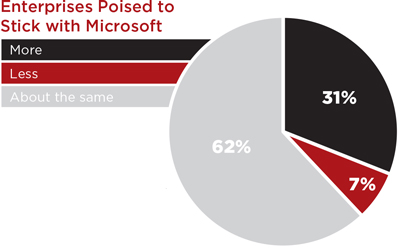 Only 7 percent report they'll spend less of their IT dollars on Microsoft-based infrastructure, 1 percent-age less than two years ago.
Only 7 percent report they'll spend less of their IT dollars on Microsoft-based infrastructure, 1 percent-age less than two years ago.
A midsize enterprise, MLS has 400 employees, mostly in New York, but also supplies IT services for the league's 19 teams operating throughout the United States. That Microsoft is the key software supplier is hardly surprising.
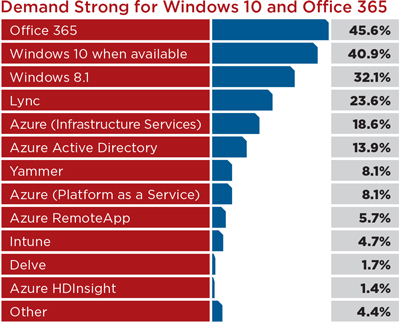 When asked about some of Microsoft's newer offerings, organizations appear to have more plans for Windows 10, due out later in the year, than the current Windows 8.1 release. It's worth noting with nearly 41 percent saying they see implementing it within the next year, only 18 percent said that about Windows 8 in our April 2013 survey. And that latter version was already shipping. It's no surprise that Office 365 came out on top, given its growth last year.
When asked about some of Microsoft's newer offerings, organizations appear to have more plans for Windows 10, due out later in the year, than the current Windows 8.1 release. It's worth noting with nearly 41 percent saying they see implementing it within the next year, only 18 percent said that about Windows 8 in our April 2013 survey. And that latter version was already shipping. It's no surprise that Office 365 came out on top, given its growth last year.
The Microsoft Enterprise Hold
A report by investment bank Piper Jaffray Companies last month found Microsoft ranked as the top primary software vendor based on a survey of CIOs. According to the survey, 24 percent of the CIOs described Microsoft as their primary, with Oracle and VMware Inc. tying for second with 16 percent selecting each. "This result is not surprising given Microsoft's long-standing leadership on the desktop, server and in the management infrastructure of key IT systems," according to the report, adding that bodes well for Redmond, given the Gartner Inc. forecast for software spending to grow 7.4 percent this year, up from last year's 6.9 percent growth.
Piper Jaffray is forecasting Microsoft's revenues will increase 9.5 percent during this calendar year, down from 11.8 percent growth in 2014. "Microsoft's broad base of existing customers, which helps to contribute to its high ranking also bodes well for contract renewals and new business, in our view."
Indeed, most of you plan to do so. According to 364 Redmond magazine readers responding to a survey conducted in late December and early January, 31 percent report planning to increase spending with Microsoft, with 62 percent expecting to spend the same. Only 7 percent say they will pay less. Until recently, such a result was expected. But given enterprise users aren't as locked into Microsoft as they once were, the findings suggest customers haven't thrown in the towel on the company despite the changes to the device landscape, new applications that require support for open source standards and the shift to cloud-based infrastructures.
"I'm super impressed with what [Microsoft has] been doing," Sullivan says, referring to Microsoft's continued embraced of open source standards and, specifically, the company's decision last year to open source its .NET Framework.
Based on responses to our survey and a variety of others, along with discussions with many thought leaders, here are some of your key marching orders. Though every organization has its own imperatives, consider these marching orders from your peers.
Welcome Windows 10
Perhaps the most interesting finding from our survey this year is the number of respondents who see deploying the new Windows 10 OS within a year of its release. A respectable 41 percent said they plan to deploy PCs with Windows 10 within a year after it ships and 30 percent will go with Windows 8.1.
To put that in perspective, nearly two years ago only 18 percent of Redmond magazine readers said they planned to deploy Windows 8 in a survey fielded six months after that OS shipped. The 41 percent now saying they'll deploy Windows 10 was all the more impressive, given it ranked second when asked which of Microsoft's "newer" offerings they plan to deploy this year. Topping the list, to no surprise, was Office 365, where nearly 46 percent say they plan to deploy it this year. Many respondents also plan to deploy Lync, Azure Infrasture as a Service (IaaS) and Azure Active Directory this year.
To be sure, when asked their client platform of choice where Windows 10 was not an option (because it's still in Technical Preview), respondents overwhelmingly see Windows 7 as their client platform of choice to replace aging PCs (57.2 percent), though not as many as in previous years.
Sullivan says he has high hopes for Windows 10. "I haven't had any major issues with it," he says. "Even if I did have any issues, I want to see what it's all about." Despite a weak reception for Windows 8.x, Sullivan believes it's a solid OS. Microsoft, he believes, learned its lesson after Vista. "I think [its] code base now going forward seems like [its] development strategy is a little bit better," he says. "There's more quality assurance there, it seems like [the company has] a much better system." Employees haven't complained about Windows 8.x, either, though there were some problems with the initial Surface Pros, he acknowledges.
Nevertheless, Sullivan says employees don't generally use the new tile-based modern UI. "We send them right to the desktop with the standard images that have run on Windows 7," he says.
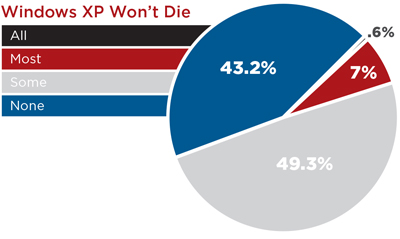 Microsoft's now-unsupported Windows XP OS still looms large, with nearly half saying they have some systems still running the defunct OS and 7 percent saying it powers most of their PCs.
Microsoft's now-unsupported Windows XP OS still looms large, with nearly half saying they have some systems still running the defunct OS and 7 percent saying it powers most of their PCs.
Sharing his enthusiasm for Windows 10 is survey respondent Charles Burton, director of information technology at Calcasieu Parish Police Jury in southwest Louisiana, which has already deployed Windows 8.1 systems. But Burton admits to being among the 57 percent that still have at least some Windows XP-based systems in the queue to be upgraded. "We've begun testing Windows 10 early releases in our shop and the response from our IT staff has been positive," Burton says. "The general platform has not changed much from Windows 8.1, but we have some added functions in the Start menu and command windows. If Windows 10 is released this year I would expect deployments limited to the IT department in our organization."
Like many enterprises that have tended to skip versions of Windows releases, Michael Hensley, CIO of Neighborhood Impact, a nonprofit community services organization serving several counties in Oregon, passed on Windows 8.x, but anticipates deploying Windows 10-based PCs. "We are still using Windows 7 and are looking forward to Windows 10 as the first logical business-centric upgrade path Microsoft has provided," Hensley says. "I have been working with the Developer Preview and find the software to already be very stable. [Because] we already use Office 365, I am hopeful that Windows 10 will provide a nearly seamless experience for our staff as we move more and more files and services to Office 365."
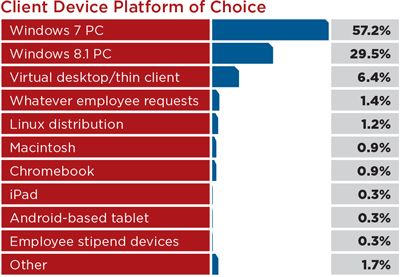 While Windows 7 remains the OS of choice to replace aging PCs and laptops, there's growing acceptance of Windows 8.1 in the enterprise.
While Windows 7 remains the OS of choice to replace aging PCs and laptops, there's growing acceptance of Windows 8.1 in the enterprise.
While 41 percent indicate they have plans for Windows 10, that means the majority are still on the sidelines for now. When told Windows 10 ranked second behind Office 365 in terms of Microsoft's newer offerings respondents plan to deploy, Michael Wigle was taken aback. "Quite frankly, that surprises me," he says. "I am still able to get Windows 7 Professional installations for my desktops and expect to be able to all year. I am doing a limited deployment of Windows 8.1 Pro for mobility devices [Surface Pro 3s], but otherwise I intend to stick to Windows 7 until the Windows 10 kinks get worked out. Then I'll probably move to Windows 10 for my next desktop refresh."
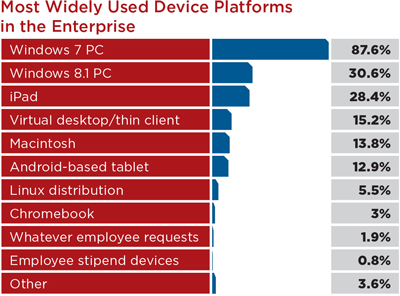 Windows PCs remain the systems of choice at work, through iPads, Android tablets, Macs and virtual desktops have a strong presence, as well.
Windows PCs remain the systems of choice at work, through iPads, Android tablets, Macs and virtual desktops have a strong presence, as well.
Many organizations that have Windows 7 remain quite happy with it and just as they have gladly passed on Windows 8.x, they're in no rush to upgrade to Windows 10, either. "We have no plans to upgrade to Windows 8.x," says Robbie Holcomb, senior systems engineer for the California Department of Parks & Recreation. Holcomb says he doesn't have enough staff to retrain the agency's 2,000 employees. "[Because] we aren't early adopters of desktop OSes, we might wait until Windows 10 SP2, hoping that the free version might be available by then."
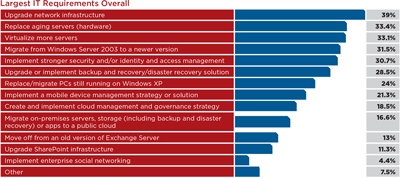 [Click on image for larger view.]
What's a priority versus the largest priority? Because organizations have multiple IT requirements, we asked the same question, allowing multiple responses. Upgrading network infrastructure is a key priority by the largest number of respondents, followed by replacing aging servers, virtualizing them and migrating aging Windows Server 2003-based systems, which Microsoft will stop supporting in July. It should come as little surprise that implementing stronger security and identity and access management also are key priorities, along with migrating off Windows XP-based systems.
[Click on image for larger view.]
What's a priority versus the largest priority? Because organizations have multiple IT requirements, we asked the same question, allowing multiple responses. Upgrading network infrastructure is a key priority by the largest number of respondents, followed by replacing aging servers, virtualizing them and migrating aging Windows Server 2003-based systems, which Microsoft will stop supporting in July. It should come as little surprise that implementing stronger security and identity and access management also are key priorities, along with migrating off Windows XP-based systems.
Eliminate Windows XP
Holcomb is among the nearly half of survey respondents noting that there are still Windows XP-based systems still in use. Only 43.2 percent say they have no Windows XP-based systems, while 49.3 percent have some. While less than 1 percent say every PC in use is Windows XP, 7 percent report most of them still run the OS, which Microsoft officially stopped issuing patches for last April. "Our desktops are 98.6 percent Windows 7 -- some of those ol' XP machines don't kill off so easily," Holcomb says. "Something that really haunts us are the old 32-bit Access databases that are now broken because of the 64-bit OS/Office Access incompatibility issues. Didn't know how many we had until they all broke."
Burton also admits to having a few remaining Windows XP-based systems in use but considers it a priority to migrate them. "Our highest priority will be to migrate out of remaining Windows XP and Windows Server 2003 systems this year," he says. While Burton may have blown the deadline for migrating his Windows XP-based PCs, he still has five months to upgrade the Windows Server 2003-based systems. Microsoft has said it will no longer support Windows Server 2003 as of July 14, 2015.
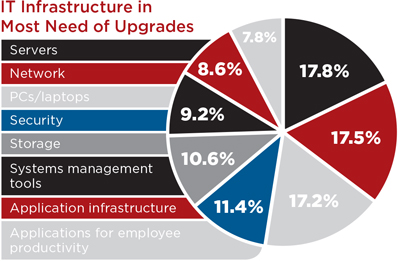 Everyone has their wish lists when it comes to system upgrades, though there's no overwhelming favorite. Servers, network gear and client devices require the most attention.
Everyone has their wish lists when it comes to system upgrades, though there's no overwhelming favorite. Servers, network gear and client devices require the most attention.
Nearly one-third, or 31.5 percent, of respondents, described upgrading their systems running Windows 2003 Server as a high priority this year, according to our survey. For Wigle at the Cincinnati Association for the Blind, upgrading those servers was third-largest priority behind Windows XP upgrades and boosting its network infrastructure.
Upgrade the Network
Upgrading network infrastructure ranked the No. 1 IT priority overall, according to our survey. When asked to pick a single top priority (where only one choice was permitted), 13.5 percent chose network infrastructure upgrades with replacing Windows XP-based PCs ranking second, at 11 percent. When the same question was asked allowing multiple responses, it was still the largest priority by 39 percent of respondents, with replacing aging server hardware coming in second at 33.4 and close behind virtualizing more servers (33.1 percent), Windows Server 2003 migration (31.5 percent) and implementing stronger security and/or identity access management (30.7 percent).
Refreshing network infrastructure also topped the list in the Piper Jaffray survey, where 35 percent of respondents ranked it as their No. 1 priority. That's a marked jump from last year's Piper Jaffray survey when 26 percent ranked upgrading network infrastructure as the top priority and 23 percent in 2013. The need to replace aging network infrastructure comes as organizations look more seriously at providing better branch office connectivity, tying together siloed infrastructures and linking to public clouds. "We must improve our network infrastructure." Holcomb says. "Being a statewide agency, we are dependent upon painfully slow WAN links, which connect back to our Sacramento headquarters. The majority of these circuits are T1 connections that are no longer suitable for the amount of data we have to protect. Not to mention that Off Highway Vehicle Parks are located in badlands where services are pretty unreliable on a good day."
 [Click on image for larger view.]
Only a small percentage have no plans to support BYOD, while 70 percent already do so in some way.
[Click on image for larger view.]
Only a small percentage have no plans to support BYOD, while 70 percent already do so in some way.
In the case of the Calcasieu Parish Police Jury, the need for upgrading the network is part and parcel of an effort to make its entire infrastructure more "application-aware," Burton explains. "Our infrastructure team will be taking on projects to update our Internet edge and interoperability systems like firewalls, BYOD and cloud infrastructure," he says. "This will bring new application-aware infrastructure monitoring and management, which will be a step up from our current tools we're using today. Our application team and I expect to be looking at new ways to leverage resources available via our cloud provider and improving app mobility across all our supported solutions."
Get a Handle on BYOD and Cloud Integration
The rise of cloud computing and BYOD are occurring in lockstep and, not surprisingly, they're enabling one another. The ability of employees to use their own devices to circumvent enterprise systems has played a key role in many IT organizations' decisions to support these systems. Only 11.9 percent of our survey respondents say they'll never allow employees to use their devices to access any enterprise systems -- even corporate e-mail. The rest are in various stages of providing access with nearly 71 percent allowing some level of connectivity.
Whether organizations have specific cloud initiatives, a strong base of respondents will be deploying at least some cloud services. As earlier noted, Office 365 tops the list of Microsoft's "newer" offerings respondents plan to deploy this year with 45.6 saying they plan to do so. Smaller percentages have various cloud computing plans including creating a cloud management and governance strategy (18.5 percent), while 16.6 percent plan to migrate their servers and storage to a public cloud. In many cases, that's for the purpose of backup or Disaster Recovery as a Service (DRaaS).
Protect the Data
"Utilizing more cloud services and virtualizing our servers is part of our disaster recovery and backup mitigation plan," says Neighborhood Impact's Hensley. "Less hosted in-house means less to backup and worry about recovering. Virtualized servers are easier to recover as they allow for bare-metal recovery that's hardware-independent." Hensley adds his cloud migration plans include compute infrastructure. "Whenever possible, we're trying to get out of the server hosting business and leveraging the cloud to provide the services we have traditionally hosted in-house. "
Sullivan (of MLS) is among those keen on shifting to Azure for disaster recovery. While he's happy with the support he gets from Rackspace Hosting for disaster recovery, MLS is using the Rackspace traditional hosting service and believes it will be more economical and make more sense to use Azure, though it would also fit into the MLS move to Office 365, Azure Active Directory and a desire to ultimately not be running so much virtualized infrastructure on-premises. "We're at a point now where we need to keep a lot of things up and running and keeping them running out of this building is probably a little bit risky," Sullivan says. "That's kind of my reason behind moving some of this stuff to Azure."
Preparing for that move is a 2015 plan -- making the move will more likely happen, he says, in 2016.